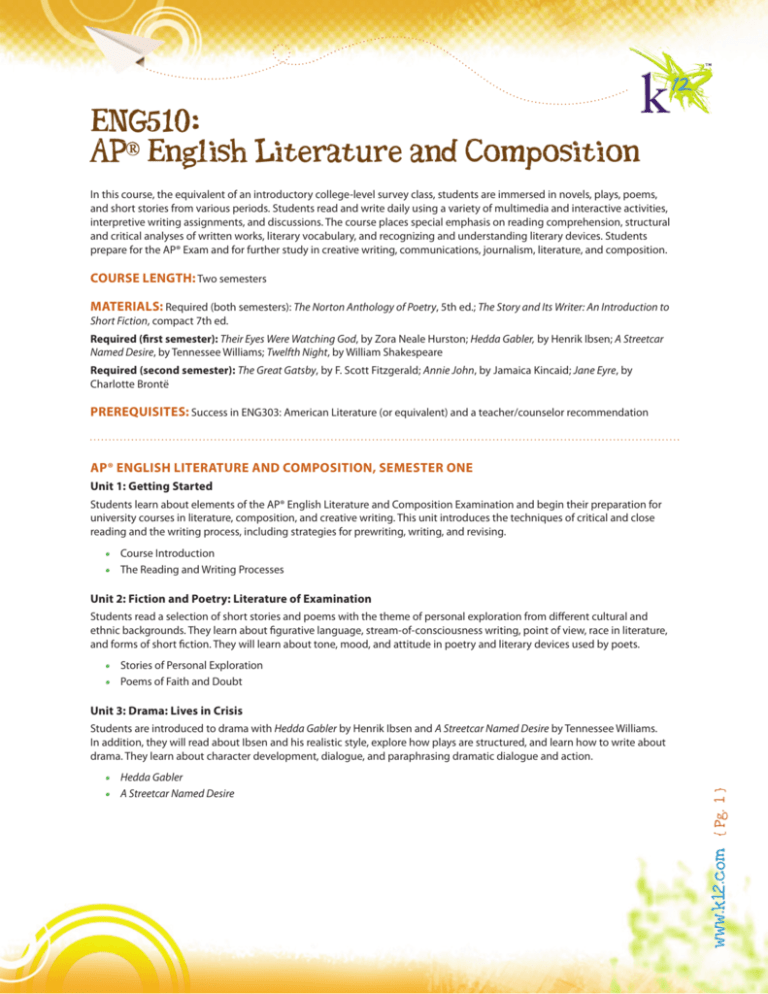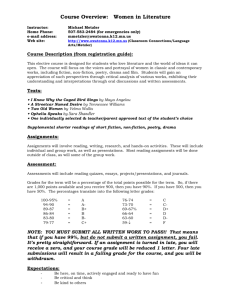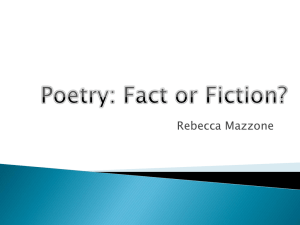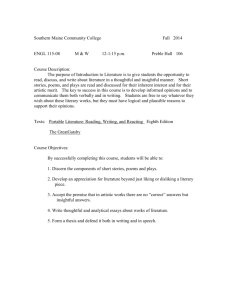
ENG510:
AP® English Literature and Composition
In this course, the equivalent of an introductory college-level survey class, students are immersed in novels, plays, poems,
and short stories from various periods. Students read and write daily using a variety of multimedia and interactive activities,
interpretive writing assignments, and discussions. The course places special emphasis on reading comprehension, structural
and critical analyses of written works, literary vocabulary, and recognizing and understanding literary devices. Students
prepare for the AP® Exam and for further study in creative writing, communications, journalism, literature, and composition.
Course Length: Two semesters
Materials: Required (both semesters): The Norton Anthology of Poetry, 5th ed.; The Story and Its Writer: An Introduction to
Short Fiction, compact 7th ed.
Required (first semester): Their Eyes Were Watching God, by Zora Neale Hurston; Hedda Gabler, by Henrik Ibsen; A Streetcar
Named Desire, by Tennessee Williams; Twelfth Night, by William Shakespeare
Required (second semester): The Great Gatsby, by F. Scott Fitzgerald; Annie John, by Jamaica Kincaid; Jane Eyre, by
Charlotte Brontë
Prerequisites: Success in ENG303: American Literature (or equivalent) and a teacher/counselor recommendation
AP® English Literature and Composition, Semester One
Unit 1: Getting Started
Students learn about elements of the AP® English Literature and Composition Examination and begin their preparation for
university courses in literature, composition, and creative writing. This unit introduces the techniques of critical and close
reading and the writing process, including strategies for prewriting, writing, and revising.
•Course Introduction
•The Reading and Writing Processes
Unit 2: Fiction and Poetry: Literature of Examination
Students read a selection of short stories and poems with the theme of personal exploration from different cultural and
ethnic backgrounds. They learn about figurative language, stream-of-consciousness writing, point of view, race in literature,
and forms of short fiction. They will learn about tone, mood, and attitude in poetry and literary devices used by poets.
•Stories of Personal Exploration
•Poems of Faith and Doubt
Unit 3: Drama: Lives in Crisis
Students are introduced to drama with Hedda Gabler by Henrik Ibsen and A Streetcar Named Desire by Tennessee Williams.
In addition, they will read about Ibsen and his realistic style, explore how plays are structured, and learn how to write about
drama. They learn about character development, dialogue, and paraphrasing dramatic dialogue and action.
•A Streetcar Named Desire
{ Pg. 1 }
• Hedda Gabler
www.k12.com
Unit 4: Poetry: Love and Separation
Students read poetry selections dealing with love and separation. They read and interpret two classic Renaissance poems,
and learn about different forms of poetry, classical allusions, and how to identify a poem’s speaker. They learn about tone,
mood, and attitude as they read four contrasting poems and examine love from the perspectives of modern poet Edna St.
Vincent Millay and contemporary poet Cathy Song. They also learn about poetic structure, sound patterns, rhyme scheme,
alliteration, and imagery.
•Love Desired
•Love Questioned
•Love Denied
Unit 5: Long Fiction: Their Eyes Were Watching God
Students read the novel Their Eyes Were Watching God by Zora Neale Hurston, one of the most prominent American writers
of the 20th century. They learn elements of magical realism and how dialect is used in fiction, explore how memory and time
work in fiction, and learn how history influences—and is reflected in—literature. They also explore the function and structure
of endings, read more about using textual evidence to support ideas, and learn helpful tips for writing about long fiction.
•Their Eyes Were Watching God, Chapters 1-10
• Their Eyes Were Watching God, Chapters 11-20
Unit 6: Drama: Shakespearean Comedy
Students read William Shakespeare’s Twelfth Night, one of his best-known comedies. It’s a tale of disguise, deception, mistaken
identity, and the strange things people believe when they’re blinded by love. Students learn to interpret Shakespeare’s
language, begin to recognize the conventions of Shakespearean drama, and consider the influence of motive and desire on a
character’s development.
•Twelfth Night, Part One
•Twelfth Night, Part Two
Unit 7: Review and Exam
Students review what they have learned and learn how to prepare for multiple-choice and free-response test questions, then
take the semester exam.
•Review
•Exam
AP® English Literature and Composition, Semester Two
Unit 1: Victorian Era Literature
Students learn about life and literature during the Victorian Era, focusing their attention on its dominant literary form—the
novel. They read Charlotte Brontë’s highly acclaimed Jane Eyre.
•Jane Eyre, Chapters 1-16
•Jane Eyre, Chapters 17-27
{ Pg. 2 }
• Jane Eyre, Chapters 28-38
www.k12.com
Unit 2: 19th-Century Literature: British & American Authors
Students learn about British Romanticism and its influence on American writers, and about the American transcendentalist
movement. Romanticism is studied through the poetry of William Blake, William Wordsworth, Percy Bysshe Shelley, Samuel
Taylor Coleridge, and John Keats. The work of the American transcendentalists reflects a movement to define spiritual and
religious beliefs with new discoveries and new modes of thought in an era of change.
•British Authors
•American Authors
Unit 3: Turn-of-the-Century Literature
This unit focuses on turn-of-the-century literature in both Britain and America. Students focus on a turn-of-the-century short
story by Joseph Conrad, “Heart of Darkness,” which tackles the controversy over imperialism by presenting a bleak look at the
economic exploitation of Africa. Students also study Charlotte Perkins Gilman’s short story “The Yellow Wallpaper,” which depicts
a woman’s increasing mental confusion after she’s treated for depression with “the rest cure” and forbidden to do any activities.
•Fiction and Analysis, Part 1
•Fiction and Analysis, Part 2
Unit 4: Modern Literature
Students read the work of Irish, American, and English poets, all concerned with changes of social order, the fragmentation of
experience, and new ways of presenting poetry. Students sharpen their skills in reading, analyzing, and writing about poetry.
•Modern Poetry, Part 1
•Modern Poetry, Part 2
Unit 5: The American Dream
Students read The Great Gatsby and other literature that explores the notion of the American dream. In addition to being an
intriguing mystery, The Great Gatsby gives a clear picture of one part of 1920s America. Students also read two poems by
Langston Hughes, an important poet of the Harlem Renaissance.
•The Great Gatsby, Chapters 1-5
•The Great Gatsby, Chapters 6-9
Unit 6: Contemporary Literature
Students read contemporary literature, including short stories by American and international authors, and the novel Annie
John. These stories address the experiences of various groups within and outside American culture, and the effect of diverse
backgrounds and cultural perspectives on literature.
•American Voices
•International Voices
Unit 7: Review and Exam
•Review
•Exam
Copyright © 2008 K12 Inc. All rights reserved. K12® is a registered trademark and the K¹² logo, xPotential and Unleash the xPotential are trademarks of K12 Inc.
www.k12.com
{ Pg. 3 }
Students review what they have learned and solidify skills for answering multiple-choice and free-response test questions,
then take the final exam.






